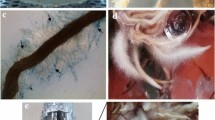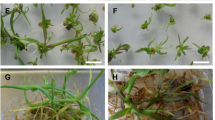Abstract
Perennial monoculture forming grasses are very important natural remediators of pollutants. Their genetic improvement is an important task because introduction of key transgenes can dramatically improve their remediation potential. Transfer of key genes for mercury phytoremediation into the salt marsh cordgrass (Spartina alterniflora) is reported here. S. alterniflora plays an important role in the salt marsh by cycling of␣elements, both nutrients and pollutants, protects the coastline from erosion, is a keystone species in the␣salt marsh supporting a large food web, which in turn supports a significant segment of economy, including tourism, has an impact on cloud formation and consequently on global weather, and is thus an ecologically important species relevant for our life-support systems. Embryogenic callus of S. alterniflora was co-inoculated with a pair of Agrobacterium strains LBA4404 carrying the organomercurial lyase (merB) and mercuric reductase (merA) genes, respectively, in order to co-introduce both the merA and the merB genes. Seven stable geneticin resistant lines were recovered. The presence of merA and merB genes was verified by PCR and Southern blotting. All but one transgenic lines contained both the merA and the merB sequences proving that co-introduction into Spartina of two genes from separate Agrobacterium strains is feasible and frequent, although the overall frequency of transformation is low. Northern blotting showed differences in relative expression of the two transgenes among individual transformants. The steady-state RNA levels appeared to correlate with the phenotype. Line #7 showed the highest resistance to HgCl2 (up to 500 μM), whereas line #3 was the most resistant to phenylmercuric acetate (PMA). Wild-type (WT) callus is sensitive to PMA at 50 μM and to HgCl2 at 225 μM.
Similar content being viewed by others
References cited
Adam P, 2002 Saltmarshes in a time of change Environ Conserv 29: 39–61
Anderson CE, 1974 A review of structure in several North Carolina salt marsh plants In: Reimold RJ, Queen WH, (eds) Ecology of Halophytes. Academic Press, New York, pp. 307–344
Ansede JH, PJ Pellechia, DC Yoch 1999 Selenium biotransformation by the salt marsh cordgrass Spartina alterniflora: Evidence for dimethylselenoniopropionate formation Environ Sci Technol 33: 2064–2069
Attila CK, RA King, C Ferris, DR Ayres, DR Strong, 2000, Reciprocal hybrid formation of Spartina in San Francisco Bay Mol Ecol 9: 765–770
Ayres DR, DR Strong, 2001, Origin and genetic diversity of Spartina anglica (Poaceae) using nuclear DNA markers Am J Bot 88: 1863–1867
Baumel A, ML Ainouche, MT Misset, JP Gourret, RJ Bayer, 2003, Genetic evidence for hybridization between the native Spartina maritima and the introduced Spartina alterniflora (Poaceae) in South-West France: Spartina X neyrautii re-examined Plant Syst Evol 237: 87–97
Bizily SP, CL Rugh, AO Summers, RB Meagher, 1999, Phytoremediation of methylmercury pollution: merB expression in Arabidopsis thaliana confers resistance to organomercurials Proc Natl Acad Sci USA 96: 6808–6813
Burke DJ, JS Weis, P Weis, 2000, Release of Metals by the Leaves of the Salt Marsh Grasses Spartina alterniflora and Phragmites australis Estuar Coast Shelf Sci 51: 153–159
Chung CH, 1989, Ecological engineering of coastlines with saltmarsh plantations In: Mitsch WJ, Jorgensen SE, (eds) Ecological Engineering: An Introduction to Ecotechnology. Wiley and Sons, New York, pp. 255–289
Croughan TP, HX Cao, RP Regan, et al. 1993, Biotechnology applications to coastal erosion control Annu Res Rep LA State Univ Baton Rouge 85: 157–160
Czakó M, Feng X, He Y, Liang D, Márton L. 2005 Genetic modification of wetland grasses for phytoremediation. Z Naturforsch 60c, 285–291
Czako M, L Marton 2001, A heartwood pigment in Dalbergia cell cultures Phytochemistry 57: 1013–1022
Daehler CC, DR Strong 1997, Hybridization between introduced smooth cordgrass (Spartina alterniflora; Poaceae) and native California cordgrass (S. foliosa) in San Francisco Bay, California, USA Am J Bot 84: 607–611
Ellstrand NC, 2003, Current knowledge of gene flow in plants: implications for transgene flow Phil Trans Roy Soc London Series B-Biol Sci 358: 1163–1170
Ferris C, RA King, AJ Gray 1997, Molecular evidence for the maternal parentage in the hybrid origin of Spartina anglica Mol Ecol 6: 185–187
Freshwater DW, 1988, Relative genome-size differences among populations of Spartina alterniflora LOISEL (Poaceae) along east and Gulf coasts of USA J Exp Mar Biol Ecol 10: 239–246
Gallagher JL, Reimold R, Linthurst R, Pfeiffer W, 1980, Aerial production, mortality, and mineral accumulation – export dynamics in Spartina alterniflora and Juncus roemerianus plant stands in a Georgia salt marsh Ecology 61: 301–312
Heaton ACP, Rugh CL, Kim T, Wang NJ, Meagher RB. 2003 Toward detoxifying mercury-polluted aquatic sediments with rice genetically engineered for mercury resistance. Environ Toxicol Chem 22, 2940–2947
Heller AA, JH Weber 1998, Seasonal Study of Speciation of Mercury(II) and Monomethylmercury in Spartina alterniflora from the Great Bay Estuary, NH Sci Tot Environ 221: 181–188
Hill RW, BA White, MT Cottrell, JWH Dacey 1998, Virus-mediated total release of dimethylsulfoniopropionate from marine phytoplankton: a potential climate process Aqua Microb Ecol 14: 1–6
Kraus ML, 1988, Accumulation and excretion of five heavy metals by the salt marsh cordgrass Spartina alterniflora Bull New Jersey Acad Sci 33: 39–43
Lee RW, 2003, Physiological adaptations of the invasive cordgrass Spartina anglica to reducing sediments: rhizome metabolic gas fluxes and enhanced O-2 and H2S transport Mar Biol 143: 9–15
Li XG, JL Gallagher 1996, Tissue culture and plant regeneration of big cordgrass, Spartina cynosuroides: Implications for wetland restoration Wetlands 16: 410–415
Li XG, DM Seliskar, JA Moga, JL Gallagher 1995, Plant-Regeneration from Callus-Cultures of Salt-Marsh Hay, Spartina Patens, and Its Cellular-Based Salt Tolerance Aqua Bot 51: 103–113
Lovell CR, CE Bagwell, M Czakó, et al.: 2001, Stability of a rhizosphere microbial community exposed to natural and manipulated environmental variability Fems Microbiol Ecol 38: 69–76
Lüttge U, 1971, Structure and function of plant glands Annu Rev Plant Physiol 22: 23–44
MacFarlane GR, MD Burchett 1999, Zinc distribution and excretion in the leaves of the grey mangrove, Avicennia marina (Forsk.) Vierh Environ Exp Bot 41: 167–175
Márton L, J Browse 1991, Facile transformation of Arabidopsis Plant Cell Reports 10: 235–239
Márton L, Chen YP, Czakó M. 2000 Method for decomposing toxic organic pollutants. US Patent No 6,087,547
McGovern TA, LJ Laber, BC Gram 1976 Characteristics of the salts secreted by Spartina alterniflora Loisel and their relation to estuarine production Estuar Coast Mar Sci 9: 351–356
Meagher RB, 2000a, Corrigendum: Phytoremediation of toxic elemental and organic pollutants Curr Opin Plant Biol 3: 435–435
Meagher RB, 2000b, Phytoremediation of toxic elemental and organic pollutants Curr Opin Plant Biol 3: 153–162
Minello TJ, JW Webb 1997: Use of natural and created Spartina alterniflora salt marshes by fishery species and other aquatic fauna in Galveston Bay, Texas, USA Mar Ecol Prog Ser 151: 165–179
Mobberley D, 1956, Taxonomy and distribution of the genus Spartina Iowa State College J Sci 30: 471–574
Mulholland MM, Otte ML. 1999 Dimethylsulfoniopropionate (DMSP) in higher plants. In. De Kok LJ, Grill D, Hawkesford MJ, Schnug E, Stulen I. eds. COST Action 829: Fundamental, Agronomical and Environmental Aspects of Sulfur Nutrition and Assimilation in Plants: Progress Report 1997/1998. Office for Official Publications of the European Communities, Luxembourg
Murashige T, Skoog F 1962, A revised medium for rapid growth and bio-assays with tobacco tissue cultures Physiologia Plantarum 15: 473–497
Odum WE, 1988, Comparative ecology of tidal freshwater and salt marshes Annu Rev Ecol Syst 19: 147–176
Otte ML, JT Morris, 1994, Dimethylsulphoniopropionate (DMSP) in Spartina alterniflora Loisel Aqua Bot 48: 239–259
Pomeroy LR, 1970, The strategy of mineral cycling Annu Rev Ecol Syst 1: 170–190
Pomeroy LR, Wiegert RG, 1981. The Ecology of a Salt Marsh (Ecological Studies 38. Springer-Verlag, New York
Rugh CL, HD Wilde, NM Stack, et al.: 1996, Mercuric ion reduction and resistance in transgenic Arabidopsis thaliana plants expressing a modified bacterial merA gene Proc Natl Acad Sci USA 93: 3182–3187
Sanger DM, AF Holland, GI Scott 1999, Tidal creek and salt marsh sediments in South Carolina coastal estuaries: II. Distribution of organic contaminants Arch Environ Contam Toxicol 37: 458–471
Sheikholeslam SN, DP Weeks 1987, Acetosyringone promotes high-efficiency transformation of Arabidopsis thaliana explants by Agrobacterium tumefaciens Plant Mol Biol 8: 291–298
Smart R, 1982, Distribution and environmental control of productivity and growth form of Spartina alterniflora Tasks for Vegetation Science 2: 127–142
Thomson WW, 1975, The structure and function of salt glands In: Poljakoff-Mayber A, Gale J., (eds) Plants in Saline Environments. Springer-Verlag, New York, pp. 118–146
Utomo HS, I Wenefrida, TP Croughan 2001, Smooth cordgrass synthetic seeds: Production, storage and potential use for coastal erosion controls TurfGrass Trends 10: 12–15
Verkleij JAC, H Schat 1991, Mechanisms of metal tolerance in higher plants In: Shaw AJ (eds) Heavy Metal Tolerance in Plants: Evolutionary Aspects. CRC Press, Boca Raton, FL, pp. 179–194
Wang JB, DM Seliskar, JL Gallagher 2003, Tissue culture and plant regeneration of Spartina alterniflora: Implications for wetland restoration Wetlands 23: 386–393
Weis P, L Windham, DJ Burke, JS Weis 2002, Release into the environment of metals by two vascular salt marsh plants Mar Environ Res 54: 325–329
Windham L, JS Weis, P Weis 2001, Patterns and processes of mercury release from leaves of two dominant salt marsh macrophytes, Phragmites australis and Spartina alterniflora Estuaries 24: 787–795
Acknowledgements
The Louisiana ecotype of S. alterniflora was kindly provided by Drs H. Utomo and T. Croughan (Rice Research Station, Crowley, LA). This research was supported by grants from the South Carolina Sea Grant Consortium. The merA and merB gene constructs were kindly provided by Dr. R. Meagher (University of Georgia, Athens, GA).
Author information
Authors and Affiliations
Corresponding author
Rights and permissions
About this article
Cite this article
Czakó, M., Feng, X., He, Y. et al. Transgenic Spartina alterniflora for phytoremediation. Environ Geochem Health 28, 103–110 (2006). https://doi.org/10.1007/s10653-005-9019-8
Published:
Issue Date:
DOI: https://doi.org/10.1007/s10653-005-9019-8




